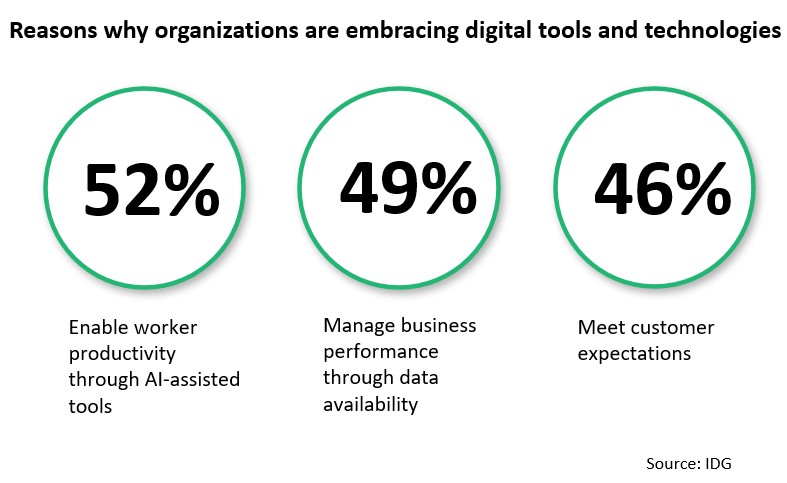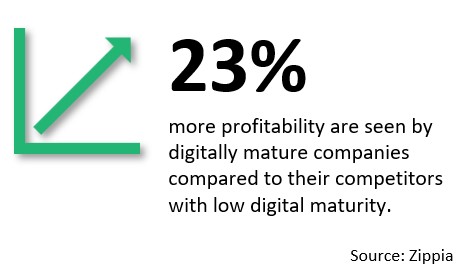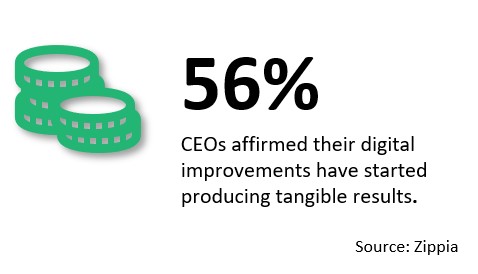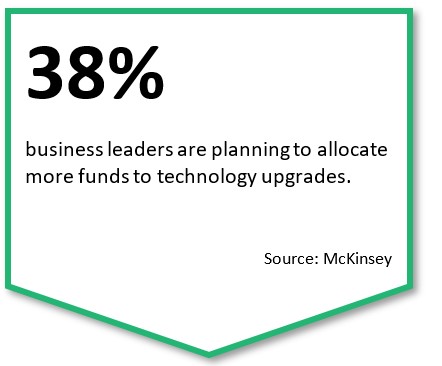
In the age of digital disruption, rapid advancements in technology are reshaping industries and revolutionizing the way we do business. The respondents of the IDG report, as shown in the figure ‘Reasons why organizations are embracing digital tools and technologies’, share the reasons why they are embracing digital tools and technologies. From traditional brick-and-mortar stores to multinational corporations, no company is immune to the transformative power of digital disruption. Embracing this wave of change can lead to unprecedented growth and success, while ignoring it may spell doom for even the most established enterprises. In this article, we will explore the impact of digital disruption on businesses and the essential examples of business level strategies to navigate this disruptive landscape. We will also analyze “what is a business level strategy” and how it can be elevated to not just survive but thrive amidst these changes.

The Digital Disruption Landscape
 Digital disruption is not a new concept, but its acceleration in recent years has been staggering. Advancements in artificial intelligence, cloud computing, data analytics, and other emerging technologies have provided organizations with unprecedented capabilities to streamline operations, create innovative products and services, and connect with customers on a deeper level. Businesses that have failed to embrace digital transformation have found themselves left behind, struggling to keep up with more agile and tech-savvy competitors.
Digital disruption is not a new concept, but its acceleration in recent years has been staggering. Advancements in artificial intelligence, cloud computing, data analytics, and other emerging technologies have provided organizations with unprecedented capabilities to streamline operations, create innovative products and services, and connect with customers on a deeper level. Businesses that have failed to embrace digital transformation have found themselves left behind, struggling to keep up with more agile and tech-savvy competitors.
According to a survey done by Zippia, digitally mature companies are 23% more profitable than their competitors with low digital maturity. This underscores the importance of integrating the digital purpose of business level strategy into your organizational model.
The Perils of Excluding Digital Disruption from Your Business Level Strategy
Digital disruption is a fundamental shift in how businesses operate. Companies that have not acknowledged this shift have experienced devastating consequences.
Kodak, once a photography industry giant, failed to embrace the digital camera revolution and eventually filed for bankruptcy.
Blockbuster, a video rental giant, ignored the potential of streaming services and eventually closed its doors.
These are just two instances of how failure to adapt to digital disruption can lead to the demise of even the most established brands.
As the saying goes, "adapt or die." Your business level of strategy must recognize and address the challenges and opportunities presented by digital disruption.
Embracing Digital Disruption: 3 Essential Strategies
Develop a Digital-Centric Culture
You must embark on a transformational journey by cultivating a digital-centric culture. By placing innovation, adaptability, and continuous learning at the core of this cultural shift, you can harness the true potential of AI-assisted intelligence to enhance the importance of business level strategy. Embrace a mindset that encourages your teams to fearlessly experiment with new technologies and processes, and where failure is celebrated as a steppingstone to success. In this digital age, the path to sustained growth and competitive advantage lies in developing a culture that embraces change and leverages AI as a powerful ally in shaping a prosperous future.
Per Zippia, 56% of CEOs affirmed their digital improvements have started producing tangible results. This demonstrates the critical role of leadership in driving a digital-centric culture.
What Steps Can You Take to Develop a Digital-Centric Culture?
- Communication and Collaboration: Foster a culture of open communication and collaboration to encourage idea-sharing and analyze what a business level strategy is.
- Training and Upskilling: Invest in training and upskilling your workforce to equip them with digital competencies, such as hands-on experience on how to leverage AI-based tools.
- Rewards and Recognition: Recognize and reward innovative efforts and risk-taking, regardless of the outcome.
- Enterprise-wide Brainstorming: Encourage cross-functional teams to work together to ideate business level strategies examples and tackle digital challenges collectively.
Leverage Data and Analytics
In the age of information abundance, you are presented with an unparalleled opportunity to unlock the hidden potential within your organizational data. Embracing advanced data analytics has become imperative for businesses seeking to thrive in a competitive landscape. By harnessing the power of data-driven insights, you can unravel valuable patterns, trends, and customer preferences, paving the way for more informed and strategic decision-making. Advanced data analytics holds the key to not only optimizing existing processes but also unearthing innovative pathways for growth and expansion. In a world where data is the new currency, businesses that tap into the vast reservoirs of information at their disposal will emerge as the true torchbearers of success.
The Zippia survey indicates that organizations that figure out what is business level strategy in a digital-first world are more likely to achieve their business goals than their peers. This highlights the potential upside of integrating predictive intelligence into your business level strategies.
How Can You Leverage Data and Analytics?
- Data-Driven Project Decision Making: Leveraging data and analytics empowers you to make informed decisions based on objective insights. By analyzing historical data and real-time information, you can identify trends, patterns, and correlations, enabling you to make strategic choices that align with business level strategy examples.
- Customer Understanding: Data and analytics offer a deeper understanding of customer behavior, preferences, and pain points. By collecting and analyzing customer data, you can create personalized experiences, targeted marketing campaigns, and tailored products or services that resonate with your target audience, ultimately leading to improved customer satisfaction and loyalty.
- Optimizing Operations: Data-driven analytics can enhance operational efficiency and effectiveness. By analyzing operational data, you can identify project bottlenecks, dependencies, and areas for improvement. This enables you to optimize processes, reduce costs, and streamline workflows, leading to increased project productivity and profitability.
- Competitive Advantage: Organizations that effectively utilize data can get a competitive edge, anticipate market trends, and respond to changes proactively. This foresight allows you to adapt quickly to market dynamics and outperform your peers.
- Predictive Project Insights: Advanced analytics, such as predictive modeling and forecasting, enable you to anticipate future trends and outcomes. This proactive approach allows you to mitigate project risks, seize opportunities, and stay ahead of potential risks. Predictive insights empower you to create resilient strategies that can navigate uncertainties and achieve sustainable growth.
Integrate Modern Solutions into Your Business Level Strategy
From operations and projects to finances and HR, innovative technologies offer transformative benefits that can vastly improve the definition of business level strategy and outcomes.
Automated processes and AI-powered tools provide the following benefits:
- Streamline operations, reducing manual errors and boosting efficiency,
- Enhance collaboration and enable real-time tracking, leading to timely and successful project deliveries,
- Provide deeper insights, facilitating data-driven financial decision-making,
- Optimize talent acquisition, engagement, and retention, fostering a motivated and productive workforce,
- Empower your organization to stay competitive, innovate, and adapt to changing market demands, driving overall growth and project success.
Which Business Functions Will Benefit from AI-Assisted Modern Solutions?
- Sales and Marketing: Predictive intelligence can analyze customer data, identify potential leads, and personalize marketing campaigns, leading to improved lead conversion rates and higher customer retention.
- Supply Chain and Inventory Management: By predicting demand fluctuations and optimizing inventory levels, AI-assisted tools ensure smoother supply chain operations, reducing stockouts and excess inventory costs.
- Financial Planning and Analysis: Advanced analytics can forecast financial performance, identify cost-saving opportunities, and assess investment risks, enabling better financial decision-making and budget optimization.
- Customer Service and Support: Predictive intelligence can anticipate customer issues, allowing you to offer proactive support, resolve problems faster, and enhance overall customer satisfaction.
- Risk Management: Predictive models can identify potential risks and vulnerabilities, allowing you to develop proactive risk mitigation strategies and examples of business level strategy and protect your assets and reputation.
- Human Resources: Predictive intelligence can aid in talent acquisition, employee retention, and workforce planning, ensuring that you have the right people with the right skills in place to meet future challenges.
Conclusion
Digital disruption is transforming every industry, and businesses that fail to embrace it are at risk of being left behind. As the landscape continues to evolve, it is essential to elevate the business level strategy definition to transcend these disruptions actively. Developing a digital-centric culture, aligning the levels of strategy in business with digital opportunities, and selecting modern solutions that support your digital vision are three essential business level strategies to ensure your business thrives in this age of disruption.
 By embracing digital transformation and digitally integrated tools, you position your organization at the forefront of innovation. Remember, the key to project success lies in not just recognizing the power of digital disruption but actively leveraging it to your advantage. Per McKinsey, 38% of business leaders are planning to allocate more funds to technology upgrades.
By embracing digital transformation and digitally integrated tools, you position your organization at the forefront of innovation. Remember, the key to project success lies in not just recognizing the power of digital disruption but actively leveraging it to your advantage. Per McKinsey, 38% of business leaders are planning to allocate more funds to technology upgrades.
Are you ready to step into the future and make digital disruption work for you, or will you be a spectator watching your competitors thrive in this new digital era?
TrueProject, an innovative predictive intelligence tool, empowers business leaders with a powerful capability: the ability to drive successful initiatives that match their vision. By harnessing advanced analytics and data-driven insights, TrueProject enables you to conduct a comprehensive evaluation of each project's potential impact on the overall digital roadmap. With this invaluable information at your fingertips, you can make well-informed decisions, ensure optimal resource allocation, and steer your organization toward successful project execution that directly contributes to the realization of your broader digital business vision.
The choice is yours, and the time to act is now. Realize “what are the business level strategies for digital disruption?” before it is too late.
More information on TrueProject can be found at: TrueProjectInsight.com
 Author the Author:
Author the Author:
Serving as the CEO at TrueProject, Tom Villani plays a major role in shaping the company's strategic direction, driving growth, and fostering a culture of innovation. Prior to his role at TrueProject, Tom worked as the Senior Vice President, Digital Innovation of CAI, Vice President of Global Alliances and Partners at Hitachi Vantara, and key senior executive roles with Information Builders, MicroStrategy and AT&T. Tom also serves in advisory board capacities in the areas of Big Data and IoT.
Endnotes:
- Ariella, Sky. “37 INCREDIBLE DIGITAL TRANSFORMATION STATISTICS [2023]: NEED-TO-KNOW FACTS ON THE FUTURE OF BUSINESS.” Zippia, November 14, 2022. https://www.zippia.com/advice/digital-transformation-statistics/
- Bughin, Jacques and van Zeebroeck, Nicolas. “The best response to digital disruption.” McKinsey Global Institute, May 9, 2017. https://www.mckinsey.com/mgi/overview/in-the-news/the-right-response-to-digital-disruption
- Eira, Astrid. “72 Vital Digital Transformation Statistics: 2023 Spending, Adoption, Analysis & Data.” FinancesOnline, June 21, 2023. https://financesonline.com/digital-transformation-statistics/
- Herzog, Mathias, Puthiyamadam, Tom and Naujok, Nils. “10 Principles for Winning the Game of Digital Disruption.” strategy+business, November 30, 2017. https://www.strategy-business.com/article/10-Principles-for-Winning-the-Game-of-Digital-Disruption
- NTT. “3 Innovation Strategies for the Age of Digital Disruption.” Harvard Business Review, November 20, 2019. https://hbr.org/sponsored/2019/11/3-innovation-strategies-for-the-age-of-digital-disruption
- Satell, Greg. “How Blockbuster, Kodak and Xerox Really Failed (It's Not What You Think)” Inc.com, July 7, 2018. https://www.inc.com/greg-satell/pundits-love-to-tell-these-three-famous-innovation-stories-none-of-them-are-true.html





